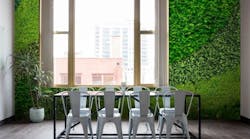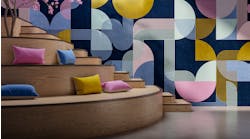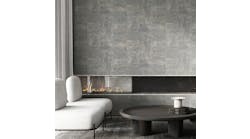Wallcoverings are one of the easiest avenues toward generating design impact in an interior space. Few interiors products upgrade aesthetics as quickly and cost-effectively. Whether you are looking for textural warmth and sophistication or high-impact color and drama, the wallcoverings market offers a vast array of affordable, sustainable and fashionable selections.
Here’s the latest looks and trends we’re seeing at the Wallcoverings Association.
1. Dramatic Digital
A game-changer in the wallcoverings industry, digital technologies have opened new possibilities for design impact and customization, offered at price points to fit within budget.
Product designers are harnessing the technology to create visually stunning large-scale graphics with vivid color, crisp detail and compelling texture. Industrial looks are on point with current design trends, including riveted metals and porous concrete. Nature themes abound, depicting everything from earthy and botanical landscapes to wood grains, striated stones and geodes.
2. Form and Function
Designers are looking to specify materials that provide a beautiful design aesthetic coupled functional performance. This is increasingly important in environments where large open collaborative spaces are replacing smaller personal spaces.
Materials such as acoustic solutions can be fabricated in a variety of forms while vastly reducing the transmission of sound within a space. Decorative wall panels bring depth and luster while providing a high-traffic design solution.
3. Design Fusion
The blending of design that carries the warmth of residential design married with the performance characteristics of commercial finishes can being seen across various market segments—hospitality, retail and healthcare.
Designers have recognized the demand for experience-based spaces, ones that will have a considerable visual impact. Vintage patterns are deconstructed and streamlined for modern appeal. Merging old and new design inspirations brings a fresh take to the wall.
Walls have become gallery space, driven by the availability of dramatic floor-to-ceiling wallcovering murals.
Designers are replacing art with wallcoverings—in lobbies and public space, headboard walls in guestrooms, elevator lobbies and restaurant focal points—providing more impact than traditional artwork; often at a lower cost.
(Photo courtesy of York.)
Digital wallcoverings are used in many of these spaces as designers take advantage of unlimited repeats and color to create awe-inspiring patterns.
Wallcoverings as art can help brand the environment, ground the interior in its geographic locale, contribute to a thematic design or establish a familial warmth.
5. Bringing the Outdoors In
The wallcoverings industry is in a unique position to promote biophilic design by providing large-expanse wall imagery that brings the outdoors in. Imagery includes depictions of forests, flowing water, stones and botanicals in nature’s palette of blues, earthy browns, tans and greens.
In a new application, designers are using large wallcovering expanses of natural imagery as powerful backdrops for smaller, more expensive and harder-to-maintain living walls. Also popular are wallcoverings that mimic wood and stone architectural details while addressing the budget and durability concerns with using natural materials.
6. Sustainable Finishes
There are more than 2,000 wallcovering selections certified to NSF 342. Unique to our industry, both manufacturer and distributor must be certified by an independent third party for a product to carry the NSF 342 designation. In addition, many companies offer Sustainability Scorecards that show exactly what credits the product received to qualify for NSF 342 certification.
[Related: Introducing Graham & Brown Wallpaper and Color of the Year 2020]
LEED v4 has recognized the NSF 342 certification and offers a Pilot Credit for certified wallcoverings. In addition, many wallcoverings offer Environmental Product Declarations that provide transparency into how they are made and enable specifiers to compare sustainable properties.
7. Sculpted Surfaces
Sculpted looks are being created by marrying century old manufacturing techniques with innovative new materials. Deep embossed textures continue to thrive within the architecture and design market as product designers combine layered texture with inks that project depth and dimension. Look for simulations of structured industrial metal, dimensional geometrics, undulating waves and irregular ridges.
8. Subtle to Shiny
Bask in burnished luxury, thanks to the popularity of Mylar. Add a pop of pizzazz with traditional high-gloss Mylar. Or opt for one of the newer looks that harness iridescence in more subtle and sophisticated applications.
Rather than all-over shine, we’re seeing bursts of radiance that peek through overlaid inks in unusual ways. Some wallcoverings have a luminous dusting that sparkles when viewed from different angles.
9. Enhanced Performance
Wallcoverings do double-duty as an aesthetically pleasing finish and durable wall protection. Type II wallcoverings shield the wall from stains and abrasions while maintaining long-term good looks. For high-traffic and high-abuse spaces, look for Type III wallcoverings or some of the newer options in flexible wall protection.
The wall protection category has been expanding over the last several years, and now offers a range of stylish designs that go on like wallcovering but stand up to heavy use, challenging stains and rolling traffic such as office chairs, luggage carts, maid carts, wheelchairs and gurneys.
Designers are requesting products with added features for abrasion resistance, impact resistance and cleanability, and manufacturers and distributors are responding with flexible surfaces with varying levels of added protection.
Minimalism is giving way to Maximalism, and bold color and pattern are on full display. Fueled by the popularity of digital wallcoverings, ’70s style large-scale geometrics and organics are making a comeback in both commercial and residential spaces.
(Photo courtesy of Flavor Paper.)
Get your groove on with geometric circles, hexagons, squares and parallelograms. Or get back to nature with oversized palms, florals, botanicals and nature scenes. At home, consumers are worrying less about matching furnishings and more about finding a pattern they love and covering the whole wall. In commercial environments, the predominance of white is giving way to bigger, brighter and bolder color, pattern, texture and form.
Read next: Hospitality Trends Inside a New Senior Living Community
About the Author:
Dan Brandt is president of the Wallcoverings Association (WA) and director of product and marketing for MDC Wallcovering. The WA is a nonprofit trade association representing wallcoverings manufacturers, distributors and suppliers. The WA educates consumers, designers and specifiers about the beauty and use of wallcoverings. The association keeps the industry at the forefront of sustainability with specifier tools such as NSF/ANSI 342, Sustainability Scorecards and Environmental Product Declarations.
Designers and design students can obtain an industry sample book from the WA.


